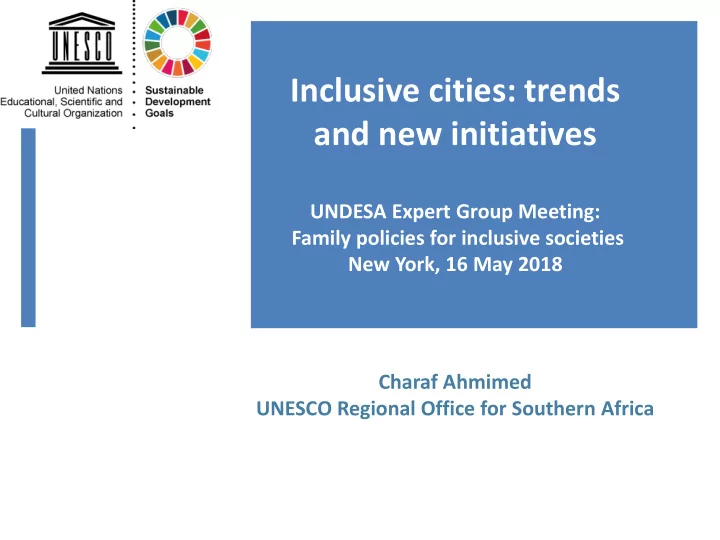

Inclusive cities: trends and new initiatives UNDESA Expert Group Meeting: Family policies for inclusive societies New York, 16 May 2018 Charaf Ahmimed UNESCO Regional Office for Southern Africa
Introduction and 2 Relevance 2050: Over 66% of the world population 80% of GDP worldwide Sustainable Development Goal 11 Three key policy approaches toward inclusivity: The inclusive city Family policies Intergenerational solidarity
3 Why the city? Capacity to reach and interact directly with constituents Municipality as the policymaker, service provider, and employer Custodian of public spaces Long-term commitment Inequalities exacerbated (within middle and upper income countries)
4
5 What is an Inclusive City? A city governed by democratic institutions, and transparency Promotes accessibility, equal opportunities, and sustainable development. The inclusive city caters to the rights and needs of groups habitually excluded
6 Intergenerational Solidarity Six dimensions of intergenerational solidarity: Structure (geographic distance) Association (frequency of social contact) Affect (feelings of intimacy ) Consensus (in opinions, values, lifestyles) Function (financial support) Norms (obligation towards other members) Silverstein, Merril, and Vern L. Bengtson. "Intergenerational Solidarity and the Structure of Adult Child ‐ Parent Relationships in American Families." American Journal of Sociology 103, no. 2 (1997): 429-60.
Trends and Good 7 Practices
Porto Alegre, Brazil 8 GINI Coefficient: 0.60 Participatory Budgeting (PB) programme Citizen involvement essential component to combatting urban inequality Regular public assemblies based on five themes Urban planning and development; public transportation; health and social welfare; education, culture and recreation; economic development Current urban development master plan Environmentally sustainable initiatives
Medellin, Colombia GINI Coefficient: 0.51 Sustainable linkages and mobilization between the poor and rest of city Community engagement, representative governance, and violence suppression agenda 2000: homicide rate of 177 per 100,000 inhabitants Number of homicides down by fourfold today
Blantyre, Malawi GINI Coefficient: 0.50 Community-Based Rehabilitation (CBR) programme to empower persons with disabilities and their job prospects Goal: increase number of eligible persons with disabilities that can open their own businesses and/or join workforce Key component : including person with disability as a committee member in Malawi Rural Development Fund
Amman, Jordan GINI Coefficient: 0.39 Child Protection Initiative (CPI) project Provisions of educational and cultural activities and services to families specifically in disadvantaged areas Youth engagement as priority in Municipality agenda Policy for Children Broadened to include children with disabilities
12 District Jhelum, Pakistan GINI Coefficient: 0.31 CBR initiative: “Inclusive Community Development through Mainstreaming People with Disability in Social Mobilization” In accordance with the CRPD Local Citizens’ Community Boards Membership from persons with disabilities
13 Indonesia 2017: 14 mayors of cities signed Charter of the Network of Indonesian Mayors for inclusive Cities in Indonesia Yogyakarta GINI Coefficient: 0.44 Committee for the Protection and Fulfillment of the Rights of People with Disabilities Access to education, political participation, public campaigns, etc.
Johannesburg, South Africa GINI Coefficient: 0.65 Integrated Urban Development Framework (IUDF) “Development synergy” Road infrastructure improvements Community police forums Community heath committees Civic education
15 Indicators for Inclusion 1. Accessible built environment Buildings and city infrastructure; public and private spheres 2. Degree of a positive social environment Attitudes, perceptions, and common knowledge 3. Affordability Financial accessibility 4. Geographical availability Inclusive policy projects
16 Indicators for Inclusion 5. Quality Information; services 6. Meaningful participation Direct engagement from targeted group; affirmative actions ; Political and civic representation 7. Transparency and good governance
17 Recommendations Policies reflecting reality of family life and today’s intergenerational experiences Comprehensive tools for families to become active participants within city management and policy making processes Breaking down institutionalized barriers, engaging youth Urgent need of creating a more accessible municipality to all ages, backgrounds, and identities
18 Recommendations Peer-learning and embracing collaborative platforms and good practices Arena for public engagement, community building, and dialogue between people and state Making cities inclusive for families with various needs
19 DON’T LEAVE MAYORS BEHIND
Recommend
More recommend